If you’re just starting your trading journey, you’ll quickly notice that traders speak their own language. Understanding key trading terms is essential before you place your first trade — whether it’s in forex, stocks, or crypto. Here are the top 10 trading terms every beginner must know in 2025.

1. Bid and Ask Price
The bid price is what buyers are willing to pay for an asset.
The ask price is what sellers want to receive.
The difference between them is called the spread, which represents the broker’s fee or market liquidity.
Example: In forex trading, if EUR/USD shows 1.1000 (bid) / 1.1002 (ask), the spread is 2 pips.
2. Leverage
Leverage lets traders control larger positions with smaller capital. For example, a 1:100 leverage means you can trade $10,000 with only $100. While it can multiply profits, it can also increase losses, so beginners must use it carefully.
3. Margin
Margin is the amount of money a trader must deposit to open a leveraged position.
If the market moves against you and your margin runs out, your broker may close the position automatically — known as a margin call.
Subscribe to receive daily reviews about Brokers worldwide
4. Lot
A lot is the standard trading size. In forex, one standard lot equals 100,000 units of the base currency. Many brokers also offer mini (10,000) and micro lots (1,000), perfect for beginners.
5. Pips
A pip (percentage in point) measures price movement in forex trading.
For most pairs, one pip equals 0.0001.
If EUR/USD moves from 1.1000 to 1.1010, that’s a 10-pip increase.
6. Stop-Loss (SL)

A stop-loss order automatically closes your trade when the price reaches a set level, preventing large losses.
Smart traders always set stop-loss levels — it’s one of the most important risk management tools in trading.
7. Take-Profit (TP)
A take-profit order closes your trade once it reaches your desired profit target.
This helps secure profits and remove emotions from decision-making.
Example: If you buy Bitcoin at $60,000 and set a TP at $62,000, your trade closes automatically once the price hits that level.
Subscribe to receive daily reviews about Brokers worldwide
8. Volatility
Volatility refers to how much the price of an asset fluctuates.
High volatility = bigger potential profits and losses.
Low volatility = more stable markets.
Crypto markets are known for extreme volatility, while major forex pairs are usually more stable.
9. Liquidity
Liquidity measures how easily you can buy or sell an asset without affecting its price.
The forex market is the most liquid in the world, while some small-cap stocks or cryptocurrencies can be illiquid — meaning harder to trade quickly.
10. Bull and Bear Markets

A bull market means prices are rising, and traders are optimistic.
A bear market means prices are falling, and sentiment is negative.
These terms apply to all markets — forex, stocks, and crypto.
Bonus Tip: Master the Language of Trading
Learning these essential trading terms helps you read charts, follow expert analysis, and understand broker platforms.
Before risking real money, try a demo account and practice using terms like pips, leverage, and stop-loss in real situations.
Frequently Asked Questions (FAQ)
Do I need to memorize all trading terms before I start?
Not all — but knowing the basics helps you trade smarter and avoid mistakes. You’ll learn the rest as you practice.
Are trading terms the same for forex, stocks, and crypto?
Mostly, yes. Terms like leverage, margin, and stop-loss apply to all markets, though details (like lot size or pip value) may differ.
Where can I learn more trading terminology?
Most brokers and trading platforms offer free trading glossaries or beginner courses. You can also practice on demo accounts to see how each term works in real time.
Conclusion

Understanding key trading terms is the foundation of becoming a successful trader.
Whether you plan to trade forex, stocks, or cryptocurrency, knowing what pips, leverage, and stop-loss mean will help you trade with confidence.
Start small, stay consistent, and always keep learning — the market rewards knowledge.
Subscribe to receive daily reviews about Brokers worldwide
Recent Brokers Reviews
Gainexo Review 2025: Is It Safe, Regulated, or a Scam?
October 6, 2025
No Comments
